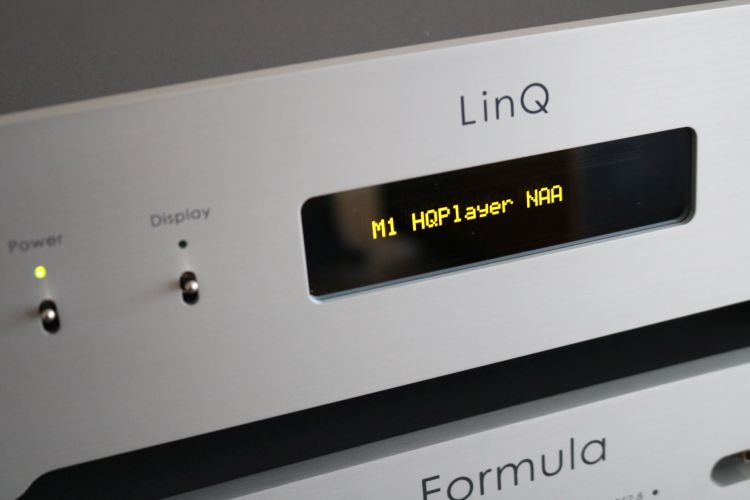
Review sample supplied by Aqua
Retail prices in the NL including 21% VAT:
LinQ including one UPnP/DLNA or HQPlayer module: 5.680 euro
Extra module: 1.280 euro
AQlink I2S cable with Ethercon (for La Scala and Formula DAC): 365 euro
AQlink new G2 I2S cable with Ethercon (for La Scala and Formula DAC): 385 euro
AQlink I2S cable with RJ45 (for La Voce DAC): 335 euro
AQlink new G2 2S cable with RJ45 (for La Voce DAC): TBA
Roon-compatible using HQPlayer
Not too long after having published the world premiere Aqua LinQ review, Roon announced that it would stop supporting hardware that is not certified or has not completed the certification process after 21 September. Prior to this, the zone would simply show a banner that said: “not certified” but, otherwise, the device would work as normal.
And, indeed, the LinQ sample that I reviewed had worked absolutely perfectly. It’s not my style to get into politics but for those who are interested in the details, there’s written plenty about it in the Roon forums. Suffice to say that the LinQ had been in the certification process for some time but due to delays, the matter was put under pressure and, consequently, decisions were made.
Aqua has chosen to retain full control over their implementations to allow them to always choose the path that best represents the core values that Aqua stands for. Further, not adhering to Roon certification allows them to release new modules or updates as soon as they are available without the need for renewed certification.
To be honest, my initial response was one of disappointment, thinking that the greatest Streaming Endpoint that I have heard would no longer work with the most user-friendly music software in existence. But fortunately, soon thereafter, I learned that Aqua was about to release a Roon-compatible HQPlayer NAA module.
The Network Audio Adaptor (NAA) is an embedded version of HQPlayer, running on a dedicated Aqua module just like the Roon and UPnP/DLNA modules. The beauty of this solution is that the software not only allows for a higher quality of streaming audio, it is also compatible with Roon.
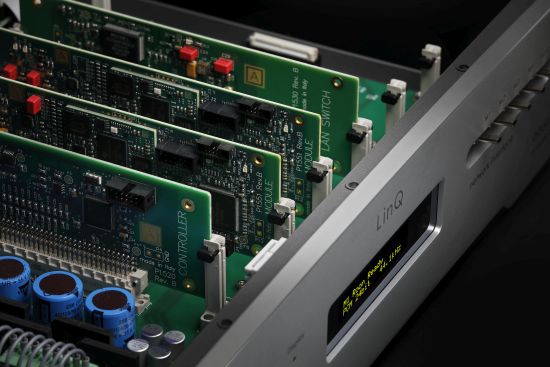
Besides the existing UPnP/DLNA module and the new HQPlayer module, Aqua has more modules on the roadmap. For instance, SqueezeLite support has just been added to the R&D agenda and the company is also working on a proprietary Audio Network Protocol along with a user-friendly Aqua web mask UI (user interface) with the default values.
This perfectly illustrates the benefits of the modularity of all Aqua products in generic and the LinQ in particular.
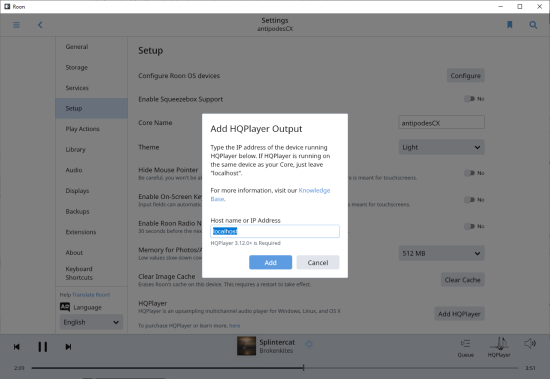
Activating HQPlayer
As a first step, the HQPlayer output option needs to be activated by clicking “Add HQPlayer” in Roon Settings – Setup. In my case, Roon runs on the Antipodes CX and so the HQPlayer Server software needs to be installed there. This is done via the Antipodes web interface, selecting the component in the “Add Software” section, and clicking “install”. This automatically installs the required software without any further user input.
With the basic installation now covered, HQPlayer needs to be told where to source its input stream (the Roon output), and where to send its output stream (for the LinQ to pick up). This is done via the HQPlayer configuration web interface. Upon first laying eyes on the config screen, when used to Roon simplicity, one may be overwhelmed by all the options that are available. I will admit that the HQPlayer Configuration interface is not very intuitive and not particularly pretty either. But it’s precisely the absolute level of control that can be asserted by the user that makes this software so powerful. The web interface also offers a help section that explains all the options and provides suggestions.
I’ll explain more about the features further below but for those who don’t want to bother experimenting and just want to get on with it, Aqua provides recommended default settings that you can enter once and then forget all about.
Under the hood, the Roon server’s output will now be redirected to the HQPlayer software which (after optional super-high-resolution upsampling, conversion and filtering) does not use Roon’s RAAT protocol but builds its own stream using a proprietary protocol for the Aqua LinQ’s HQPlayer module to pick up.
The final step is to simply select HQPlayer as the streaming endpoint in the Roon Zone section.
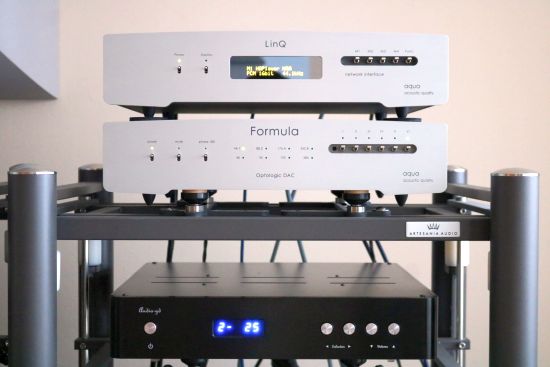
For this review, the LinQ was used with the Formula xHD with V2 output board and the Audio-GD Master 1 preamp
Caveats
Due to the re-routing of the audio stream and the HQPlayer FIFO audio buffer, there is a 3-second delay after starting, scrubbing, skipping or stopping the music from the Roon interface. HQPlayer Embedded operates without a license key in trial mode for 30 minutes at a time and then needs to be restarted to continue. The license costs 240 euros.
The delay is not ideal and 240 euros is not pocket change. I’m with you so far. However, there is one major upside: better sound quality!
I should note that the latest HQPlayer Desktop 4.7.1 release has the following new options: Quick pause and short buffer option to use half-size FIFOs for reduced delay. The same is true for version 4.19 of the embedded software while embedded version 4.20.0 reportedly has a delay near to zero. Lastly, for the custom Network Protocol that Aqua is working on, they will try to further reduce the delay.
Update 22-11-2020 – Quick Pause and Short Buffer
At the time of review, my Antipodes CX was running version 4.18.1 and a later version was not yet available. But version 2.8 of the Antipodes system software is now available for the EX and CX and it includes LSM 8.0 as well as HQ Player embedded Server version 4.20.0.

With my CX freshly updated and having enabled Quick Pause and Short Buffer as above and also having entered 20ms as the Buffer time instead of the default 100ms, the response time is improved so much as to no longer being a factor. Pause is instant, play is near-instant and resuming after seeking (scrubbing) within a track takes 2 seconds.

Using HQPlayer’s stream output without any adjustments
Although Signalist, the maker of HQPlayer, has not intended the software to be used as such, if you do not want to make use of its extensive processing capabilities, it can be used with all settings in bypass, meaning that the sound is still obtained from Roon and delivered via the HQPlayer protocol but not upsampled or filtered or otherwise changed. This is how I listened to it for the purpose of this review. If you are not interested in exploring the advanced HQPlayer options you can skip to the Listening section.
Advanced HQPlayer options
HQPlayer offers an advanced DSP pipeline for audio processing. As Jussi of Signalyst claims, the HQPlayer software offers “a much more powerful and accurate upsampling engine than Chord’s M-Scaler or dCS or Esoteric hardware, at a much more reasonable price”.
The software can operate as a digital-in-digital-out upsampler processor and convolution engine. Selectable convolution algorithms are included for digital room correction and other equalization purposes. The Convolution engine supports RIFF (WAV) format FIR impulse responses, which can be produced with suitable software, such as Acourate, Room EQ Wizard, Audiolense, or DRC.
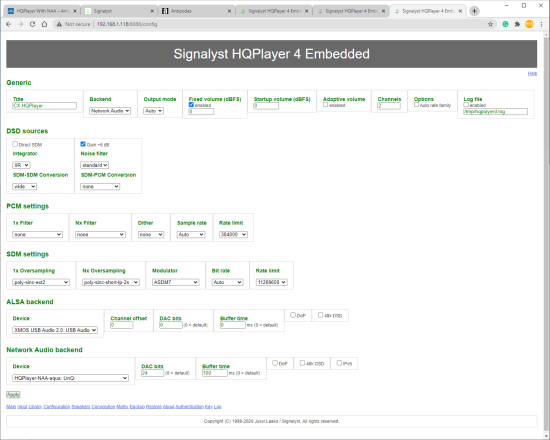
Above: the HQPlayer main Configuration screen
The list of features is so very extensive that I will list only the highlights. These include Software upsampling / downsampling with selectable algorithm up to 32-bit 3.072 MHz or down to 16-bit 32 kHz PCM, Delta-Sigma modulators for upsampling PCM content up to 98.304 MHz 1-bit SDM, Direct DSD up / down rate conversions, Selectable dithering/noise shaping algorithm, Selectable convolution algorithm (FIR) for equalization, such as digital room correction for PCM/DSD content, Software-based digital volume control for PCM and SDM (DSD), Playback of DSF/DSDIFF files through any supported audio interface (with PCM conversion and DSD rate conversion), Selectable algorithm and noise filters for DSF/DSDIFF PCM playback and Native/direct playback of DSF/DSDIFF files (native DSD, DoP v1.1 with both 0x05/0xFA and 0x06/0xF9 markers).
That’s quite the mouthful, right? Those who want to go crazy can do so to their heart’s content. Those who simply want to get on with it can simply set the parameters once and never give it a second thought.
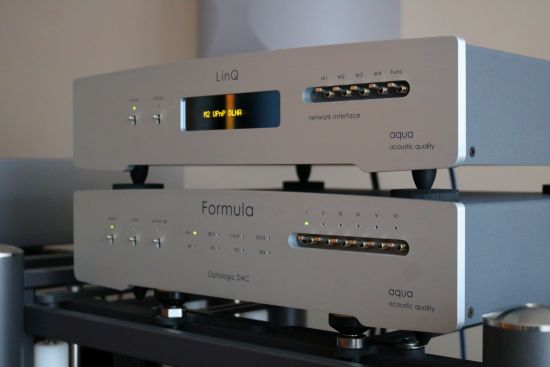
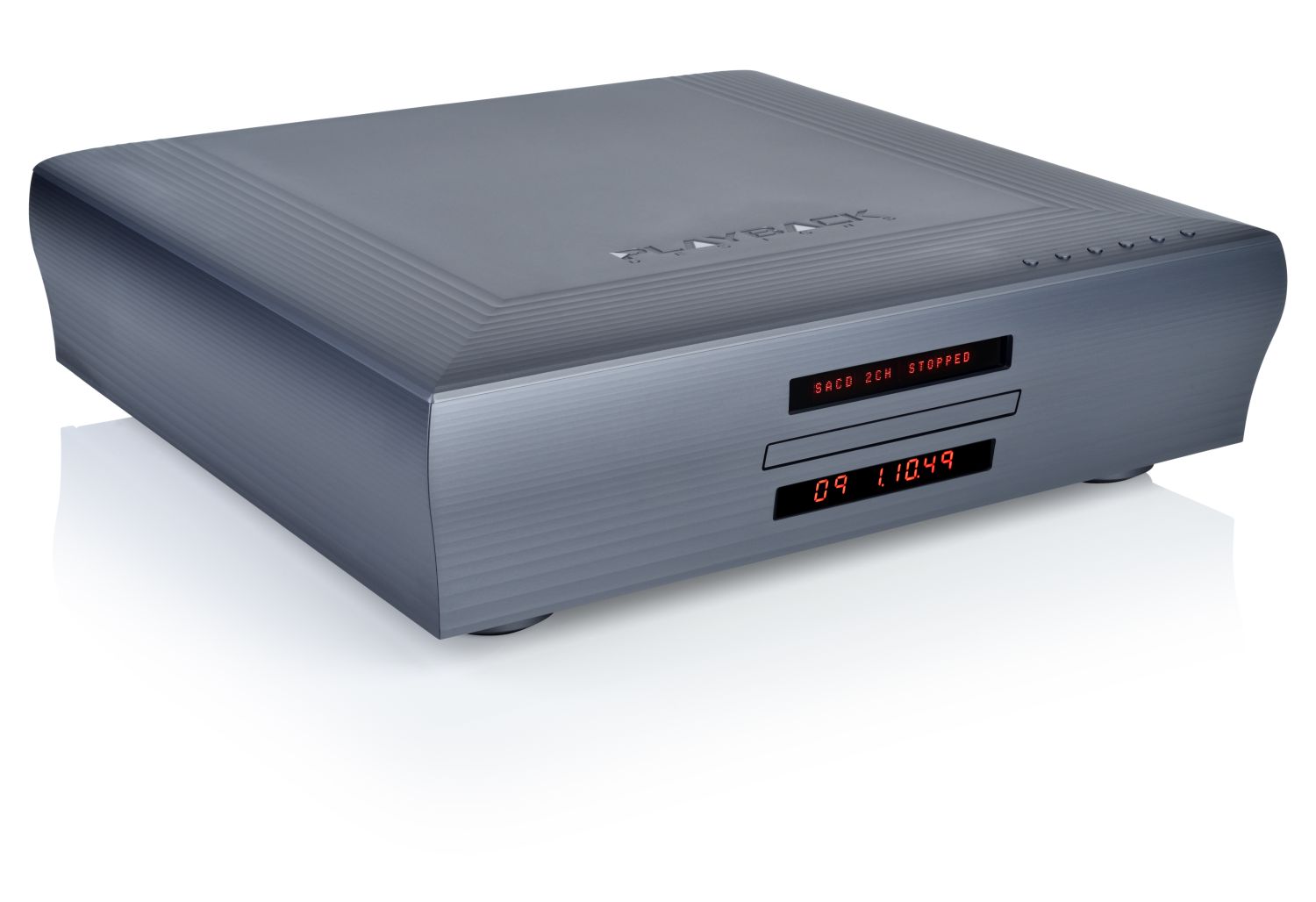







I am currently using JRiver on a PC with a JCat Femto card connecting directly to my Aqua Formula XHD. I built an Intel NUC Roon Rock this past weekend to try. I installed Roon Bridge on the same PC where I run JRiver. The sound quality is pretty close to Jriver, with some tracks sounding slightly better on Roon and some better on JRiver.
Is there a use case for a LinQ for me? I have been reading about it and thought it would be nice to eliminate the PC in my listening room and be able to stream from Roon on the Intel NUC but if I will still need to keep a full blown PC for HQPlayer then is it worth doing? Or should I run JRiver on the Intel NUC instead of Roon and then stream to the LinQ?
Hi John, I’ve no experience with the JCAT Femto USB card but even when presuming that it is very good (which it most likely is indeed), I am confident that the LinQ will further improve things for you. The main idea behind using a separate network endpoint (renderer/streamer) is that it is isolated from all the noise that is inevitably generated inside a PC. As I understand it, it is extremely hard to prevent this noise to travel along on a USB connection. UTP has galvanic isolation built into the protocol but even so, further isolation still pays off. That’s one of the reasons why audiophile switches can make an audible difference. You will need HQPlayer if you want to stream Roon to the LinQ but it’s not required to use a full-blown PC for that. You can also use a NUC for the Roon/jRiver/HQPlayer software indeed and you can even place that computer in another room. BTW, if you don’t need Roon and will stick with jRiver, I’d suggest using UPnP. It’s easy to set up and sounds best and you won’t need HQPlayer.
Hi Christian,
Can you give your opinion on S/Q for Antipodes K50 into Aqua La Scala Optilogic 11 compared with LinQ/HQ player to La Scala .
I have Cx/Ex combo with La Scala dac and was about to upgrade to K50 but after reading your positive review of Aqua LinQ I would appreciate your thoughts.
Hi Lee, although the LinQ has the tendency to reduce the influence of upstream equipment, you can still hear the difference between the CX and the K50 even when streaming to it. But really between the K50 and the LinQ, it comes down to the following two questions. Do you want the smoothest and most organic sound? Then go for the K50 and use its AES or S/PDIF outputs or use its USB output for a tighter and more controlled delivery. Do you want the highest, fastest, most articulate, and most transparent sound? The go for the LinQ.
Hi Christiaan,
Thanks for your input, I’m going to audition both to be sure as I think either product will sound great but as you point out it comes down to personal preference. Appreciate the great reviews.
Indeed:-) Happy listening Lee!
HI Christiaan,
Did you find any difference using NAA module in Aqua and HQ core is running on the computer with Roon vs HQ Core + NAA module in Aqua and only Roon is running on the computer? I tend to think that as less processing streaming does the better.
Hi Bogdan, while there is some truth to convictions such as “linear power supplies are better”, “processors must not work hard”, or “in server/streamer solutions, the hard work must be done by the server”, there are always exceptions and it all depends on the implementation. In the case of using the LinQ purely as a HQPlayer streamer or using it with the Core+NAA module, I found the latter to sound best. You can read all about this in the latest installment of the LinQ review. Why is it better in this case? I don’t really know. Perhaps it’s because the hardware is now optimized for the software? In any case, I can tell you that inside the LinQ, the NAA renderer module and the Core+NAA module are on separate boards and in separate slots.
Hi Christiaan,
Many thanks for your interesting and insightful reviews. I have Aqua LaScala Optologic mk2 dac and consider future upgrade by adding LinQ streamer/interface. I am potentially interested in getting LinQ with NAA and HQplayer core modules based on my current experience with HQplayer embedded which I am enjoying almost daily. I typically play music from Audirvana Studio (Mac) to HQplayer embedded on PC, the latter as UPNP renderer connected to Aqua dac. I also use mConnect and JPlay controllers on iPhone to stream local library from NAS via Minim Server (also on NAS) and of course Tidal and Qobuz. My apologies for this extensive description of my listening habits.
Long story short, do you know if HQplayer core module retains its UPNP capabilities or is this function stripped. I do not use Roon and if UPNP is not implemented in Core module it will be no go for me. I would opt for DLNA module instead.
Would greatly appreciate your comments.
Hi Chris, The HQPlayer Core + NAA module is optimized around NAA and does not support UPnP. For that, you will indeed need the separate UPnP module. Or both:-)
hi
how to update with last update available of Signalyst HQPlayer 4 Embedded my Aqua run with 4.30.3 version but 4.35.2 is available, and it’s possible to upgrade for 5 version ?
thank you
For this, I would suggest checking with your dealer or with Aqua.